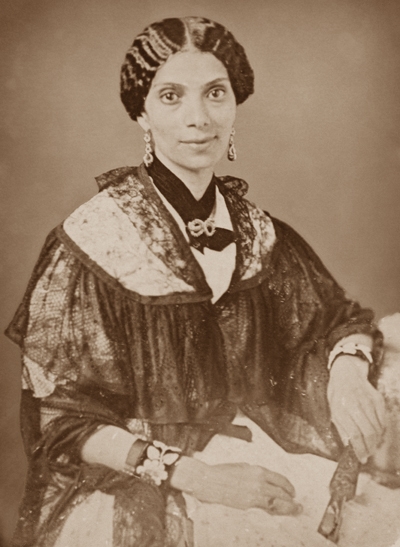Mary Smith Kelsey Peake, a pioneering educator, is one of few African American women to have a school, The Mary Peake Center of Hampton Public Schools, and a street, the Mary Peake Boulevard, named in honor due to her work as the first teacher for the newly freed slaves in Fortress Monroe, Virginia. In collaboration with the American Missionary Association (AMA), Peake’s School, located in Brown’s Cottage on the land of present-day Hampton University, is considered the predecessor to Hampton.
Born free in Norfolk, Virginia, sometime in 1823, she was the daughter of Sarah “Sally” Kelsey, a free-colored woman and a white Englishman. Their union, though illegal, did not deter them from providing Kelsey with an education. This unwavering support from her parents played a crucial role in shaping her future. At age six, Kelsey attended a private school for Black children in Alexandria, Virginia, then part of Washington, D.C., for four years. She later enrolled in a school at the First Baptist Colored Church in Alexandria, where she learned various kinds of needlework and dressmaking.
By 1839, at the age of 16, Kelsey was teaching reading, writing, and the Bible. During the day, she worked as a seamstress, but at night, she taught in her home at a time when it was illegal to teach free and enslaved Black people to read and write. Despite the grave risks to her freedom and her life, Peake secretly educated men and women, a testament to the cause of educational freedom for Black people.
In 1847, Kelsey moved to Hampton, Virginia, with her mother and stepfather, Thompson Walker, and founded The Daughters of Zion. This benevolent organization provided food, shelter, and clothing for the poor and the sick. She also joined the First Baptist Church in Norfolk, which Rev. James A. Mitchell then led.
In 1851, Peake married Thomas D. Peake, a dispatcher for the U.S. Army and previously enslaved commercial sailor. They had one daughter, Harriet Hatti Daisy Peake, born in 1856. Shortly after the Civil War began in 1861, the American Missionary Association (AMA) called on General Benjamin F. Butler, then in command of the Union Army at Fortress Monroe, Virginia, to establish a sanctuary for the formerly enslaved in the Hampton Roads area which included education, employment, and protection against future enslavement.
The AMA sent Lewis C. Lockwood to start a school, and he hired Peake as its first teacher to teach six newly freed slaves. Peake’s original classroom was underneath a large oak tree, later called the Emancipation Tree. The tree would become a National Monument due to Peake’s classroom and the later reading of the Emancipation Proclamation there.
In 1861, Smith fainted from symptoms of tuberculosis after maintaining a grueling teaching and philanthropic schedule. Although bedridden, she continued teaching students. Mary Smith Peake died on the night of February 22, 1862, at the approximate age of 39, from tuberculosis with her husband, Thomas D. Peake, her mother, students, and members of her church family by her side. Peake was buried at the Elmerton Cemetery in Hampton, Virginia. During her brief lifetime, Smith taught over 500 students from Alexandria, Newport News, Norfolk, and Hampton, Virginia. Her tombstone reads, “First Teacher of the Freedmen at Fortress Monroe, Virginia.”
Do you find this information helpful? A small donation would help us keep this available to all. Forego a bottle of soda and donate its cost to us for the information you just learned, and feel good about helping to make it available to everyone.
BlackPast.org is a 501(c)(3) non-profit and our EIN is 26-1625373. Your donation is fully tax-deductible.
L.C. Lockwood, Mary S. Peake: The Colored Teacher at Fortress Monroe. (Boston: American Tract Society, 1862).
Jessie Carney Smith, ed. Notable Black American Women (Detroit: Gale Research, 1992)
Diana Kristine Durham, “Mary Smith Kelsey Peake (1823–1862),” Dictionary of Virginia Biography, Library of Virginia (1998– ) (http://www.lva.virginia.gov/public/dvb/bio.asp?b=Peake_Mary/

